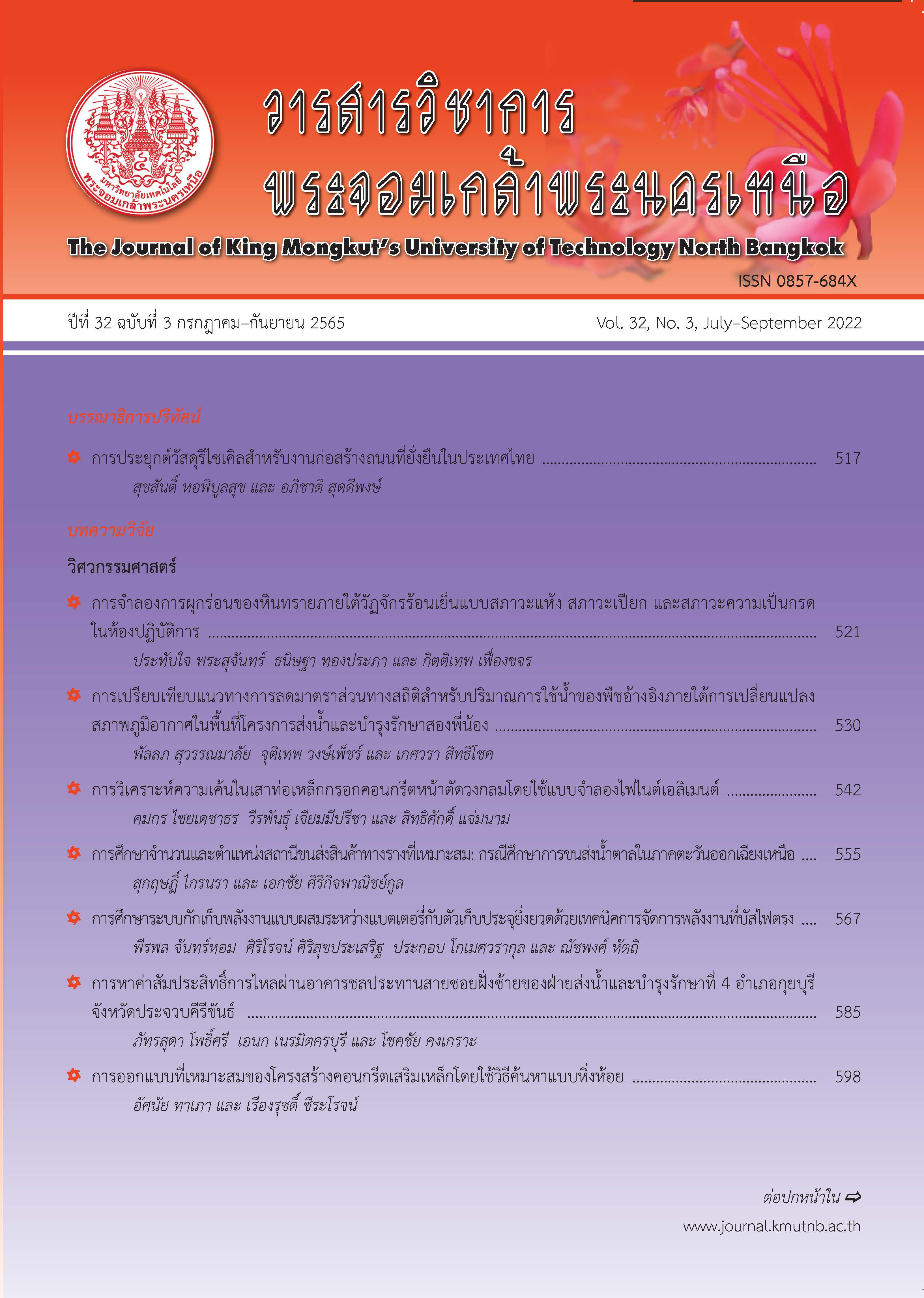ระดับการต้านทานการเกิดคาร์บอเนชั่นของคอนกรีตที่ทาสีในสภาวะแวดล้อมจริง จังหวัดนครปฐม
Main Article Content
บทคัดย่อ
งานวิจัยนี้เป็นการศึกษาระดับการต้านทานการเกิดคาร์บอเนชั่นของคอนกรีตที่ทาสีในสภาวะแวดล้อมจริง จังหวัดนครปฐม โดยคอนกรีตมี 3 ประเภทคือ คอนกรีตปูนซีเมนต์ปอร์ตแลนด์ประเภทที่ 1 ล้วน คอนกรีตผสมเถ้าลอยร้อยละ 20 และ 40 ในปูนซีเมนต์ปอร์ตแลนด์ประเภทที่ 1 (OPC) ใช้สีน้ำอะครีลิคสำหรับทาภายนอกเคลือบผิวคอนกรีตแล้วทดสอบความลึกคาร์บอเนชั่นหลังจากสัมผัสสภาวะแวดล้อมจริง จังหวัดนครปฐมเป็นระยะเวลา 120, 210 และ 300 วัน ผลการศึกษาพบว่า กำลังอัดประลัยของคอนกรีตผสมเถ้าลอย มีค่าน้อยกว่าของ OPC ล้วนที่อายุ 28 วัน ส่วนการเกิด คาร์บอเนชั่นของคอนกรีตผสมเถ้าลอยมีค่ามากกว่าของปูนซีเมนต์ปอร์ตแลนด์ประเภทที่ 1 ล้วน ในขณะเดียวกันคอนกรีตปูนซีเมนต์ปอร์ตแลนด์ประเภทที่ 1 ล้วนทาสีน้ำอะครีลิคช่วยลดค่าสัมประสิทธิ์คาร์บอเนชั่นได้มากถึง 78 % คอนกรีตผสมเถ้าลอยร้อยละ 20 ทาสีน้ำอะครีลิคช่วยลดค่าสัมประสิทธิ์คาร์บอเนชั่นได้มากถึง 71 % และคอนกรีตผสมเถ้าลอยร้อยละ 40 ทาสีช่วยลดค่าสัมประสิทธิ์คาร์บอเนชั่นได้มากถึง 70 % เมื่อเทียบกับคอนกรีตชนิดเดียวกันที่ไม่ได้ทาสี สุดท้ายสามารถคำนวณอัตราส่วนการต้านทานคาร์บอเนชั่นของสี จากคอนกรีตปูนซีเมนต์ปอร์ตแลนด์ประเภทที่ 1 ล้วน และคอนกรีตผสมเถ้าลอย ภายใต้สภาวะแวดล้อมจริง จังหวัดนครปฐมได้ โดยผลที่ได้สามารถนำไปใช้ในการวางแผนดูแลบำรุงรักษาโครงสร้างคอนกรีตเสริมเหล็กที่ต้องเผชิญกับสภาวะแวดล้อมคาร์บอเนชั่นตลอดจนป้องกันความเสียหายที่จะเกิดขึ้นในอนาคตได้
Article Details

อนุญาตภายใต้เงื่อนไข Creative Commons Attribution-NonCommercial-NoDerivatives 4.0 International License.
บทความที่ลงตีพิมพ์เป็นข้อคิดเห็นของผู้เขียนเท่านั้น
ผู้เขียนจะต้องเป็นผู้รับผิดชอบต่อผลทางกฎหมายใดๆ ที่อาจเกิดขึ้นจากบทความนั้น
เอกสารอ้างอิง
A. Petcherdchoo, “Sustainability and durability of structures,” The Journal of KMUTNB, vol. 22, no. 1, pp. 208–214, 2012 (in Thai).
S. K. Roy, K. B. Poh, and D. O. Northwood, “Durability of concrete accelerated carbonation and weathering studies,” Building and Environment, vol. 34, no. 5, pp. 597–606, 1998.
J. Khunthongkeaw, S. Tangtermsirikul, and T. Leelawat, “A study on carbonation depth prediction for fly ash concrete,” Construction and Building Materials, vol.20, pp. 744–753, 2006.
C. D. Atis, “Accelerated carbonation and testing of concrete made with fly ash,” Construction and Building Materials, vol 17, pp. 147–152, 2003.
N. I. Fattuhi, “Carbonation of concrete as affected by mix constituents and initial water curing period,” Materiaux et Constructions, vol. 19, pp. 131–136, 1986.
S. Hussain, D. Bhunia, and S. B. Singh, “An experimental investigation of accelerated carbonation on properties of concrete,” Engineering Journal, vol. 20, pp. 29–38, 2016.
B. Warinlai and P. krammart, “Basic properties and carbonation of concrete replaced with different binders,” SWU Engineering Journal, vol. 13, no. 1, pp. 27–38, 2017 (in Thai).
Department of Highways. (2015, September). Traffic Volume Retrieved. [Online]. Available: https://www.data.go.th/dataset/item_4be8c846-a4db-4ec4-99dd-59688b9e0dea
K. Attavanich and K. Maleesee, “Evaluation carbonation depth in various coating of concrete surface,” in Proceedings the 7th Annual Concrete Conference, 2011, pp. 197–202 (in Thai).
M. A. Sanjuan and C.D. Olmo, “Carbonation resistance of one industrial mortar used as a concrete coating,” Building and Environment, vol. 36, pp. 949–953, 2000.
M. Sugiyama, “Long-term carbonation performance of the concrete covered with the elastic paint with heat deterioration,” in Proceedings the 5th International Conference on Sustainable Construction Materials and Technologies, 2016, pp. 1–8.
J. B. Aguiar and C. Junior, “Carbonation of surface protected concrete,” Construction and Building Materials, vol.49, pp. 478–483, 2013.
Standard Test Method for Fineness of Hydraulic Cement by Air-Permeability Apparatus, ASTM Standards C 204-00, 2000.
Standard Test Method for Density of Hydraulic Cement, ASTM Standards C 188-95, 1995.
Part 108 Method of Making Test Cube from Fresh Concrete, British Standard Institute BS 1881, 1983.
Standard Practice for Petrographic Examination of Hardened Concrete, ASTM Standards C 856-04, 2004.
Standard Guide for Painting Inspectors (Concrete and Masonry Substrates), ASTM Standards D 6237, 2009.
B. Warinlai and P. krammart, “The risk of carbonation induced corrosion of pedestrian bridge structures in community area Nakhon Pathom province,” Journal of Engineering, RMUTT, vol. 13, no. 2, pp. 43–54, 2015 (in Thai).
B. Warinlai and P. krammart, “Accelerated and real carbonation situations of concrete,” The Journal of Industrial Technology, vol. 14, no. 1, pp. 50–62, 2018 (in Thai).
RILEM Committee, “CPC-18 Measurement of hardened concrete carbonation depth,” Material and Structure, vol. 21, pp. 453–455, 1988.
B. Warinlai and P. Krammart, “Slump compressive strength chloride penetration resistance and carbonation of concrete with partial replacement of cement by fly ash, ground bottom ash, limestone powder,” The Journal of KMUTNB, vol. 31, no. 3, 2021 (in Thai).
S. K. Roy, D. 0. Northwood, and K. B. Poh, “Effect of plastering on the carbonation of a 19-year-old reinforced concrete building,” Construction and Building Materials, vol. 10, pp. 267–272, 1996.
L. J. Parrott, A Review of Carbonation in Reinforced. UK: British Cement Association, 1987.
B. Warinlai and P. krammart, “Basic properties and carbonation of concrete replaced with different binders,” SWU Engineering Journal, vol.13, no.1, pp. 27–38, 2017 (in Thai).
S. Rukzon and P. Chindaprasirt, “Strength and carbonation model of rice husk ash cement mortar with different fineness,” Journal of Materials in Civil Engineering, vol. 22, pp. 253–259, 2010.

